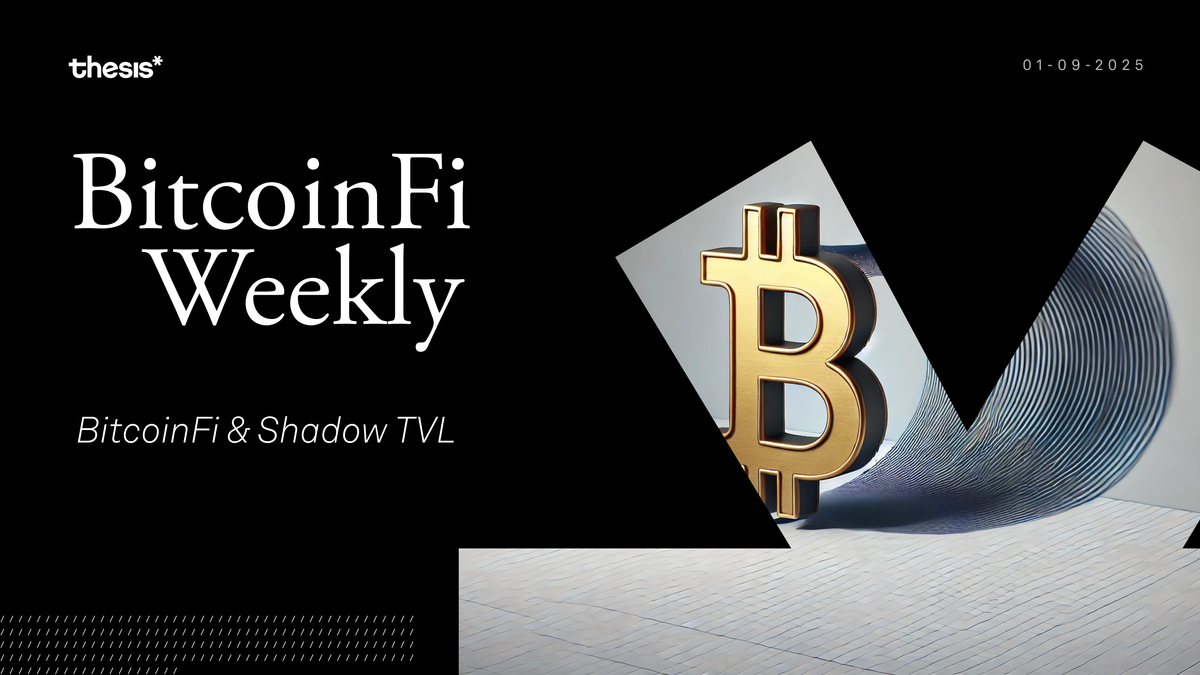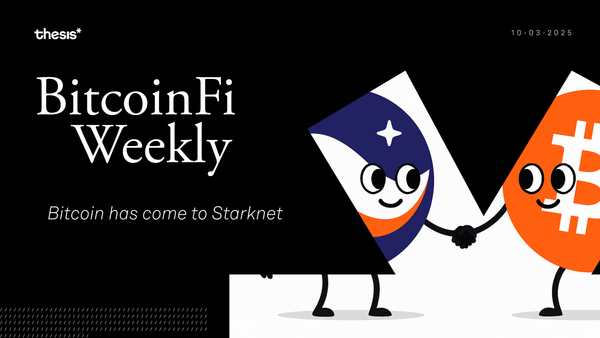BitcoinFi & Shadow TVL
In today’s BitcoinFi Weekly, we examine these dynamics in detail. From inflated metrics in staking protocols to the structural gaps in Bitcoin-pegged assets, we explore how the drive for growth often collides with the need for integrity.

Welcome to BitcoinFi Weekly. We cover where people use their BTC and what is changing in the Bitcoin world.
One of the most reliable patterns in technology is that the things that matter most are often invisible at first. The early internet was dismissed as a toy for academics. The first smartphones were seen as overpriced PDAs. And now we're seeing a similar pattern with Bitcoin's financial infrastructure. While the mainstream financial press obsesses over price movements and ETF flows, something more fundamental is happening: the emergence of a new financial stack built on Bitcoin's bedrock of trust minimization. But there's a catch, and it's one that threatens to undermine the very principles that make Bitcoin valuable. As protocols compete for attention in this emerging landscape, they fall into an old trap: conflating nominal metrics with actual value.
Here’s this week’s rundown:
🌑 Feature Piece: BitcoinFi’s Shadow TVL Problem
💰 BTC Loans at 9% via Libre: Institutional Custody with MPC Sharding
🏛️ Exodus Wallet Goes Public on NYSE
🔮 Thesis’ Bitcoin Predictions for 2025
⚖️ Understanding Bitcoin-Pegged Assets and Their Custodians
Feature Piece: BitcoinFi’s Shadow TVL Problem
One of the most reliable ways to spot trouble in early stage projects is when the metrics they tout don't match reality. This pattern is playing out right now in BitcoinFi, and if we're not careful, it could undermine everything that makes Bitcoin valuable.
The core issue: protocols are claiming billions in Total Value Locked without actually having control over or the ability to slash those funds.
Let’s consider how Bitcoin’s UTXO model complicates the story. Unlike Ethereum’s account-based structure, Bitcoin transactions operate on discrete outputs with strict spending rules. This makes tracking and locking BTC a far messier process. Most TVL figures in Bitcoin staking protocols are self-reported, relying on opaque methodologies. This creates opportunities for protocols to inflate their numbers.
Here’s a typical scenario:
1. A whale deposits BTC into a protocol.
2. The protocol assigns a “staking” address jointly controlled by the whale and the protocol.
3. The protocol counts the BTC as staked—and thus part of its TVL.
But there’s a catch. The whale retains ultimate control of the funds. The protocol cannot enforce slashing, nor can it prevent the whale from withdrawing or reusing the BTC elsewhere. In reality, these funds are neither staked nor locked—they’re just passing through.
The solution isn't complex, but it requires something many protocols seem unwilling to do: tell the truth. Real TVL should only count Bitcoin that the protocol actually controls and can slash. Anything else is just shadow TVL.
Protocols like Babylon offer a path forward. By leveraging Bitcoin’s Taproot capabilities, they can implement staking lock scripts that enforce clear rules for how BTC is staked, tracked, and withdrawn. For example:
- Staking transactions send BTC to Taproot addresses with specific lock conditions.
- Ownership is verified on-chain using public keys from both the staker and the protocol.
- The result is full transparency and verifiability, where every staking transaction can be audited.
BitcoinFi Updates
BTC Loans at 9% via Libre: Institutional Custody with MPC Sharding
In just weeks, you'll be able to take BTC-backed loans at 9% interest through Libre. This is made possible by a permissionless pool of USDT liquidity, earning lenders 8% and creating a simple, efficient system for Bitcoin-backed loans. Your Bitcoin stays yours. When you repay the loan, you get back the exact same BTC—not someone else’s—thanks to a “no-rehypothecation policy” and zero mixing.
Your Bitcoin is held in a segregated vault address. Libre uses MPC sharding (TSS) instead of private keys. You can always verify your holdings in real-time, offering peace of mind that’s rare in the space.
Libre’s 9% rate is a game-changer, especially compared to centralized platforms charging 14–18% plus origination fees. Think of it as a more focused version of Aave, built only for Bitcoin and USDT. Unlike systems that rely on wrapped Bitcoin or custodians like BitGo, Libre ensures your Bitcoin remains native and secured by TSS nodes with no reliance on middlemen.
Of course, risks exist. Libre’s architecture is starting with a limited beta and will undergo rigorous audits before scaling. Every loan is backed by unique on-chain outputs, like Ark’s transaction batching, with no bridges, alternative consensus mechanisms, or additional blockchains.
Exodus Wallet Goes Public on NYSE
Exodus Movement Inc., a self-custodial wallet, has officially graduated from the OTC Markets (OTCQX) to the New York Stock Exchange (NYSE) American.
Founded in 2015, Exodus gained recognition for supporting multiple protocols, including Bitcoin and Algorand, and has steadily evolved alongside the industry. Its stock, previously trading under the ticker “EXOD,” surged to an all-time high of $41 last December, fueled by anticipation surrounding the NYSE listing. With a debt-free model, Exodus maintains significant reserves (over 1,900 BTC and 2,660 ETH).
However, this did not come without its hurdles. Back in May, the SEC blocked Exodus' uplisting attempt. But with a shift in the U.S. regulatory climate—driven by President-elect Donald Trump’s pro-crypto stance—the SEC approved the move at the eleventh hour. This listing marks a historic moment: the first time common stock has been tokenized on a blockchain.
Despite the fanfare, the market response has been lukewarm. EXOD shares tumbled 10.71% in the last 24 hours, settling at $35.10, even as the stock maintained a 14% gain over the past five trading days.
Thesis’ Bitcoin Predictions for 2025
Extrapolated from their 2024 State of Bitcoin Report, Thesis has released 10 Bitcoin predictions for 2025. Here is a TLDR:
- Bitcoin L2s/sidechains won't surpass EVM chains in TVL (~230k BTC on EVMs vs ~92k on Bitcoin layers will persist)
- Ordinals' cumulative market cap will overtake Runes (currently $647M vs $1.2B) as fast-chain gambling prevails
- Microstrategy's NAV premium will exceed 5x (currently ~2x) during Bitcoin's next major rally
- Bitcoin dominance will make a new all-time low, dropping below its 2017 low of 37.64%
- Bitcoin ETF flows will surpass 2024's record of $44 billion as TradFi integration deepens
- Traditional Bitcoin bridges will become obsolete, replaced by BitVM and new opcode-enabled solutions
- WBTC supply will drop below 100k BTC as users shift to decentralized custody options like tBTC
- Global Bitcoin adoption will reach 180 million users (1.5-1.7x increase from 2024's 106M)
- Bitcoin mining will evolve into core energy infrastructure with sophisticated financial products and grid integration
For the full report, check out this blog.
Understanding Bitcoin-Pegged Assets and Their Custodians
Recently, Bitcoin Layers founder Janusz provided a detailed overview of how Bitcoin-pegged assets function across various blockchains, layers, and protocols.
At their core, these assets involve depositing on-chain Bitcoin with a custodian who issues a derivative token on another network, guaranteeing its redemption for the original Bitcoin later. Custodians vary widely, from centralized entities like Coinbase, BitGo, and Binance to federated setups like Stacks or ThresholdDAO’s distributed signatory models.
While some custodians publish transparent proof of reserves, such as public Bitcoin addresses or cryptographic attestations, others provide limited disclosures, raising concerns about the integrity of backing mechanisms.
Janusz highlights a key issue with transparency: “With a number of these protocols, the disclosure is simply listed in a blog post or their documentation site. Also, reserves, most of the time, are simply a list of bitcoin addresses on a webpage. We don’t really know if they’re, in fact, an address managed by the relevant custodians.”
Users must ask critical questions: Do the custodians provide proof of reserves? Are the custodians or networks trustworthy? Even in distributed setups, the derivative remains an IOU, relying on both the custodian and operator to honor redemptions.
For further details, check out Janusz’s comprehensive breakdown.
Closing Thoughts
And so it is with all great transformations in human affairs: first comes the shadow of truth, then its distortion by those who would profit from appearances rather than substance, and finally, inevitably, the light of reality breaks through. Just as a forest cannot grow in darkness, protocols building on Bitcoin cannot truly flourish while obscured by the shadows of artificial metrics.
Yet, something profound in the very nature of our permissionless culture fills me with an inexorable hope. Unlike the institutions of old, where gatekeepers and revelations guarded truth came only through appointed prophets in suits, our world is one where any person, anywhere, may speak truth to power. And just as surely as spring follows winter, this freedom to scrutinize, debate, and reimagine will guide us toward systems that honor the letter and the spirit of Bitcoin.
We invite you to read Thesis’ full State of Bitcoin 2024 report for a comprehensive analysis of Bitcoin's transformative year. This extensive research piece covers every major development that shaped Bitcoin's journey this year, from institutional adoption through ETFs to technical innovations in the protocol layer. You can download the complete report here.
Thank you for tuning in to this week’s BitcoinFi Weekly. See you next week.
If there's a topic you’d like us to cover or have questions, reach out at [email protected].
Learn more about Mezo at the following channels:
👾 Discord: https://discord.mezo.org
🕊 X: https://twitter.com/MezoNetwork
🖥 Website: https://mezo.org
🏦 Deposit Portal: https://mezo.org/hodl
ℹ️ Docs: https://info.mezo.org





